Abstract
In Japan’s agriculture of lettuce, a type of leafy vegetable, data from 2022 shows that the national harvest volume was the highest at 5.99kt. The cultivated area was also the largest in the country in the same year, at 334 hectares, indicating that lettuce cultivation is carried out over a wide area. In terms of shipping volume, Chiba Prefecture had the highest volume at 1.26 kt, showing differences in production volume between regions. The trend so far has been that there is high demand for salad greens and while they are grown all over the country, some areas, particularly Chiba Prefecture, are emerging as production centres. In the future, production volume and cultivated area are likely to expand in response to increasing demand.
Salad lettuce harvest volume (main data).
The harvest volume of lettuce, a leafy vegetable crop in Japanese agriculture, has been on the rise overall, looking at data from 1989 to 2022. It peaked in 2021 with a record harvest of 9.78kt. However, it has since declined somewhat, dropping to around 61.2% of 9.78kt in 2022. Factors contributing to this decline include climate change and changes in agricultural policies. Additionally, since salad greens are in high demand, adjustments to the balance between supply and demand may also be a factor. In the future, issues such as promoting sustainable agriculture and improving productivity through technological innovation will be a challenge, and it will be necessary to ensure appropriate production volumes in response to demand.
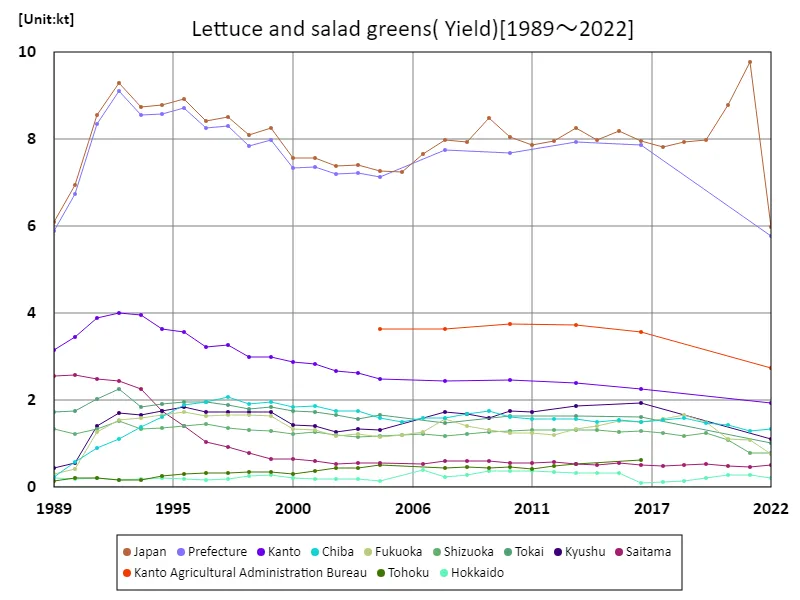

The maximum is 9.78kt[2021] of Japan, and the current value is about 61.2%
Lettuce harvest volume of salad greens (by prefecture).
Looking at the latest data for 2022 regarding leafy vegetable harvests in Japanese agriculture, Chiba Prefecture recorded the highest harvest at 1.33kt. This is the highest value among the prefecture-specific data, indicating that Chiba Prefecture is a major region for leafy vegetable production. This may be due to the fact that Chiba Prefecture has suitable climate and soil conditions, providing an environment ideal for agriculture. Additionally, while other prefectures are also cultivating leafy vegetables, it is clear that Chiba Prefecture has achieved exceptionally high yields. The current trend is that production is driven by demand, with production volumes varying from region to region. In the future, improving production efficiency and promoting sustainable agriculture will become important, and each region will be required to make the most of its local resources to increase productivity.
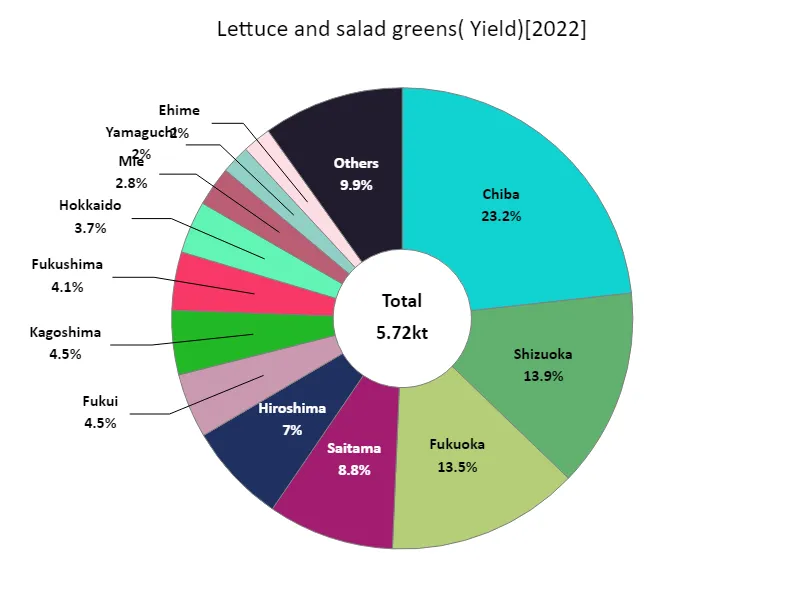

The maximum is 1.33kt of Chiba, the average is 179t, and the total is 5.72kt
The area of lettuce cultivated as salad greens (main data).
Looking at data from 1989 to 2022, the area cultivated with lettuce, a leafy vegetable crop in Japanese agriculture, has been on an overall downward trend. In 1992, the total cultivated area nationwide peaked at a record 516 hectares. However, it has since declined and is now at 64.7% of its peak. This decline may be due to factors such as the urbanization of farmland and changes in agricultural structure. Changes in demand and conversion to other crops may also be contributing to the decline in planted area. Although salad greens consumption has remained relatively stable, production may be declining due to fluctuations in demand and market competition. In the future, in response to changes in demand and the promotion of sustainable agriculture, efforts will be required to improve productivity and efficiency while ensuring appropriate cultivated area.
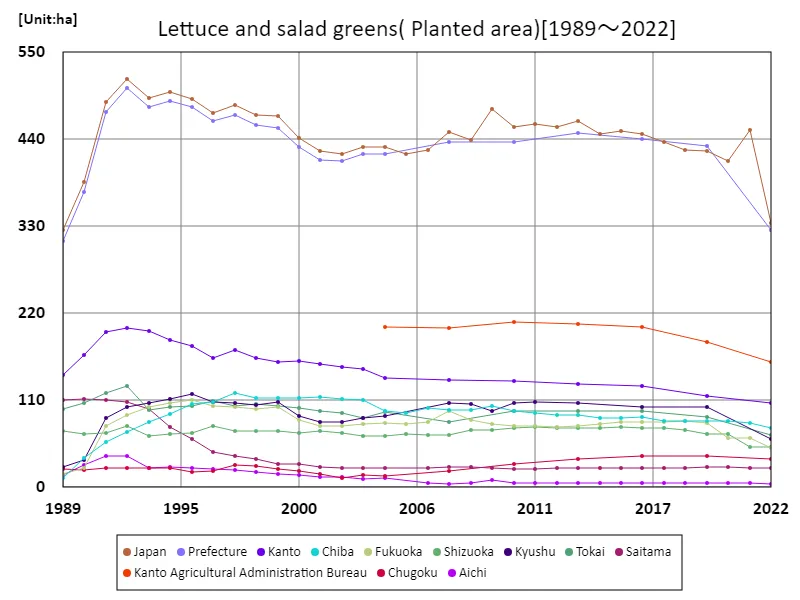

The maximum is 516ha[1992] of Japan, and the current value is about 64.7%
The area of lettuce cultivated as salad greens (by prefecture).
According to data from 2022, in terms of the area planted with leafy vegetables in Japanese agriculture, the largest value is 75ha in Chiba Prefecture, which is currently the largest. This is the highest value among the data by prefecture, suggesting that Chiba Prefecture is a major region for the cultivation of leafy vegetables. Chiba Prefecture has suitable climatic and soil conditions, and may have an environment suitable for growing leafy vegetable crops. The data also show that while other prefectures are also working on cultivating leafy vegetables, Chiba Prefecture is achieving particularly outstanding results. A notable feature so far is that the area planted with leafy vegetables varies by region, with some regions tending to lead others. Additionally, increases or decreases in cultivated area may be influenced by factors such as seasons, weather conditions, and agricultural policies. In addition, demand and market trends also influence the area under cultivation, and there may be a tendency for cultivation to expand in response to increasing demand. In the future, it will be important to promote sustainable agriculture and improve productivity through technological innovation. Making the most of local resources and ensuring that each region has adequate planting area to meet demand will be key to maintaining sustainable levels of leafy vegetable production.
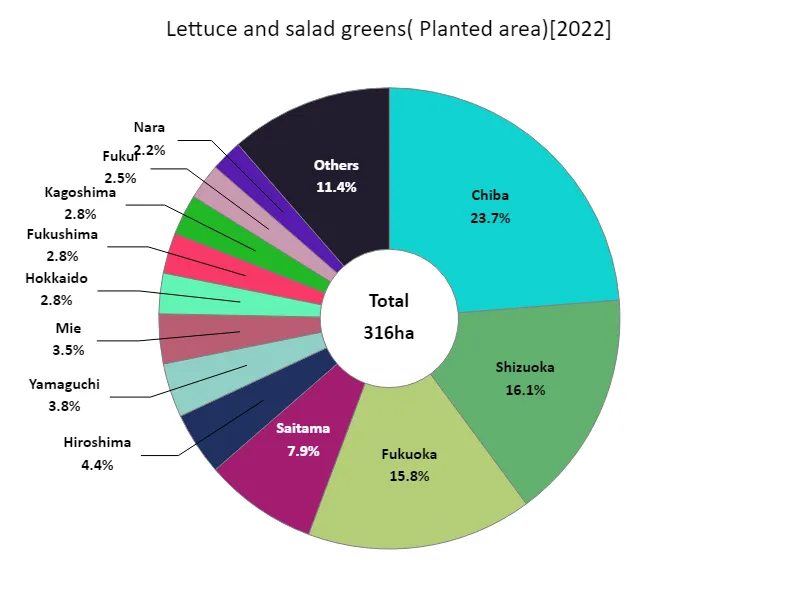

The maximum is 75ha of Chiba, the average is 9.88ha, and the total is 316ha
The shipping volume of salad lettuce.
In 2022, the overall shipment volume of leafy vegetables, especially lettuce, in Japanese agriculture was highest in Chiba Prefecture at 1.26kt, with an average of 166t and a total of 5.32kt. This data shows that production of leafy vegetables tends to be concentrated in certain areas. The fact that Chiba Prefecture recorded the highest shipping volume indicates that this region is one of the major lettuce producing areas. Also, the average shipment of 166 tonnes suggests that some regions have large-scale production while other regions have relatively small production volumes. Such differences in shipping volumes between regions are thought to be due to differences in climatic conditions, land use, and agricultural techniques. Furthermore, the total shipment volume of 5.32kt suggests that demand for lettuce is above a certain level. As salad greens are a common food ingredient with stable demand, it is assumed that these shipments are produced to meet market demand. In the future, it will be necessary to promote sustainable agriculture and introduce efficient production methods while responding to changes in demand and fluctuating climate conditions. It is also important to take steps to reduce the production disparities between regions and achieve more equal agricultural development.
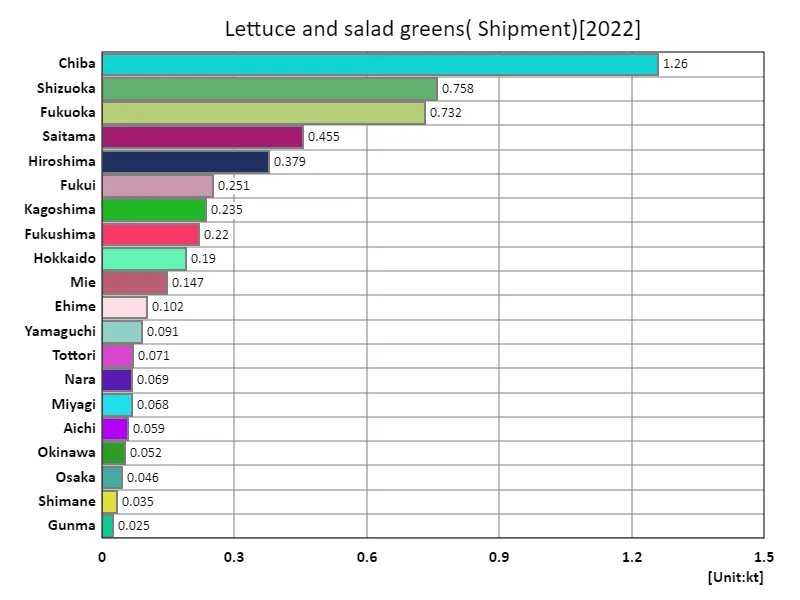

The maximum is 1.26kt of Chiba, the average is 166t, and the total is 5.32kt
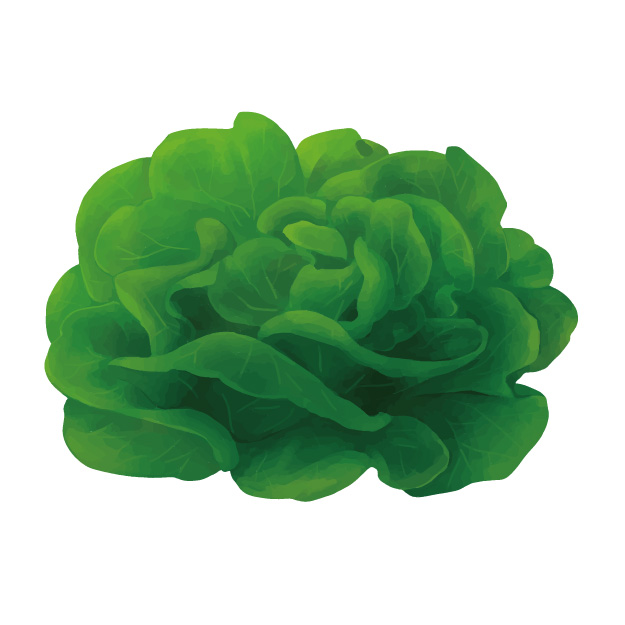


Comments